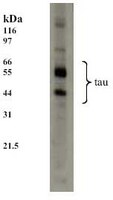577801 Sigma-AldrichAnti-Tau Mouse mAb (TAU-5)
This Anti-Tau Mouse mAb (TAU-5) is validated for use in Frozen Sections, Immunoblotting, Immunoprecipitation, Paraffin Sections for the detection of Tau.
More>> This Anti-Tau Mouse mAb (TAU-5) is validated for use in Frozen Sections, Immunoblotting, Immunoprecipitation, Paraffin Sections for the detection of Tau. Less<<Recommended Products
Przegląd
| Replacement Information |
|---|
Tabela kluczowych gatunków
| Species Reactivity | Host | Antibody Type |
|---|---|---|
| H, M, R, Sh | M | Monoclonal Antibody |
Products
| Numer katalogowy | Opakowanie | Ilość/opak. | |
|---|---|---|---|
| 577801-100UG | Ampulka plastikowa | 100 μg |
| References | |
|---|---|
| References | Papasozomenos, S.C. and Shanavas, A., 2002. Proc. Natl. Acad. Sci. USA 99, 1140. Rapoport, M., eta al. 2002. Proc. Natl. Acad. Sci. USA 99, 6364. |
| Product Information | |
|---|---|
| Form | Liquid |
| Formulation | In PBS. |
| Preservative | None |
| Quality Level | MQ100 |
| Physicochemical Information |
|---|
| Dimensions |
|---|
| Materials Information |
|---|
| Toxicological Information |
|---|
| Safety Information according to GHS |
|---|
| Safety Information |
|---|
| Product Usage Statements |
|---|
| Packaging Information |
|---|
| Transport Information |
|---|
| Supplemental Information |
|---|
| Specifications |
|---|
| Global Trade Item Number | |
|---|---|
| Numer katalogowy | GTIN |
| 577801-100UG | 04055977265910 |
Documentation
Anti-Tau Mouse mAb (TAU-5) MSDS
| Title |
|---|
Anti-Tau Mouse mAb (TAU-5) Certificates of Analysis
| Title | Lot Number |
|---|---|
| 577801 |
References
| Przegląd literatury |
|---|
| Papasozomenos, S.C. and Shanavas, A., 2002. Proc. Natl. Acad. Sci. USA 99, 1140. Rapoport, M., eta al. 2002. Proc. Natl. Acad. Sci. USA 99, 6364. |
Citations
| Tytuł | |
|---|---|
|
|
| Data Sheet | ||||||||||||||||||||||||||||||||||||||||||||||
|---|---|---|---|---|---|---|---|---|---|---|---|---|---|---|---|---|---|---|---|---|---|---|---|---|---|---|---|---|---|---|---|---|---|---|---|---|---|---|---|---|---|---|---|---|---|---|
|
Note that this data sheet is not lot-specific and is representative of the current specifications for this product. Please consult the vial label and the certificate of analysis for information on specific lots. Also note that shipping conditions may differ from storage conditions.
|








